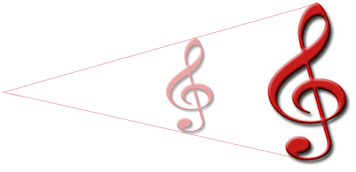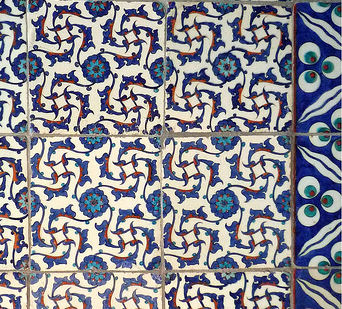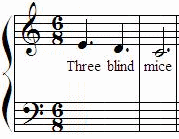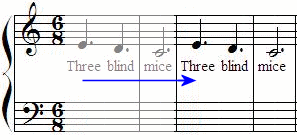Music and transformation geometry
By Murray Bourne, 08 Sep 2010
Transformation geometry involves moving geometric shapes from one place to another, and studying the characteristics of such moves.
Transformations come in 2 main types - those where the resulting image has the same size and shape as the original (translation, reflection and rotation), and those where there is a change in size (dilation).
Let's look at these more closely.
In translation we move each point on the object a fixed distance.

TRANSLATION
Reflection through a line gives us the mirror image of the original.

REFLECTION
In rotation, we rotate the object around a point. In the example below, I have rotated the treble clef 40° in a clockwise direction about the point P.

ROTATION
You can combine any of the above transformations.
It is even possible to map the original image onto itself (for example, rotating the object by 360° will bring it back to its starting position).
Finally, dilation involves increasing or decreasing the size of the original object. In the example below, a scale factor of 2 has been applied to the original small treble clef to achieve the larger one. In this case, the shape of the image is the same, but the size changes.

DILATION
Islamic art makes extensive use of transformational geometry. Repeated tiles are examples of translations and we can see each tile would map on to itself if rotated 90°.

Islamic tiles [Image source]
Transformation geometry and music
Many of the techniques used in writing music can also be described using the concepts of transformation geometry. Let's look at a simple example.
Three Blind Mice
Many of you would have learned Three Blind Mice when you were a child. Here are the opening 2 bars.

What happens next is very common in music - those 3 notes are repeated. This is like translation in geometry:

To get the next phrase, the composer just translated the pattern up by 2 notes (from E to G). In music, this is called a sequence. He then repeats that bar (another translation to the right):

Three Blind Mice is a round, which means one group (in blue, below) starts singing and after 4 bars, they sing something else ("see how they run"), while a second group (in dark red), sings the opening "Three blind mice".

After those 4 bars, another group joins in singing the opening (another translation), while the second group has gone on to "see how they run" and the first group has gone on to "they all run after the farmer's wife".
So a round is an example of a piece of music constructed around translation.
Canons and Fugues
For around 500 years up to the time of Mozart, canons and fugues could be heard in churches and concert halls throughout Europe. Canons and fugues are similar to rounds in that one voice (or instrument) starts by itself and is joined by another voice singing that same melody, perhaps in a higher or lower voice.
Actually, rounds are examples of special canons.
Bach's Crab Canon
This is a fascinating canon by Bach. It is played forward, then backward, then flipped upside-down and played from both ends!
In this video, the music is cleverly placed on a Mobius Strip (a surface with only one side).
This is a great example of transformation geometry in music!
My own Fugue in A Minor
I recently wrote a fugue. The opening melody starts in A minor and modulates to D minor (a translation, of sorts) where we hear the next entry of the main theme.
A fugue is more "free" than a round in that it changes key and there is development of the theme, usually in several different keys.
My fugue is in the style of Bach for the most part, but has a Jacques Loussier jazz feel in the middle.
So here is my fugue. I hope you enjoy it (it's just over 2 minutes. Unfortunately, it's quite soft so pump up the volume.) After it loads, press the "play" button at the top left of the music:
[Fugue in A Minor by Murray Bourne. Embedded from NoteFlight.]
Some background information:
Here is a (color-coded) Bach fugue (Note the geometry in this example!):
And here is Jacques Loussier, the French jazz pianist, playing Air on a G String by Bach in jazz style:
See the 13 Comments below.
26 Sep 2010 at 9:42 am [Comment permalink]
I did not know i was surrounded by maths in this way. Thanks
27 Sep 2010 at 10:08 am [Comment permalink]
As a lover of both mathematics and Bach, I found this article most interesting. Pythagoras was one of the earliest mathematicians to make the connection between music and mathematics. There is an excellent graphical representation of Bach's D Minor Toccata and Fugue at https://www.youtube.com/watch?v=ipzR9bhei_o.
27 Sep 2010 at 7:49 pm [Comment permalink]
Thanks Bevo. I recently discovered that YouTube video. It's great - and has been watched nearly 9 million times!
1 Dec 2010 at 3:56 am [Comment permalink]
Libnitz once said: Music is an exercise of Maths.
1 Dec 2010 at 2:33 pm [Comment permalink]
Hi Paulino. Leibniz also said:
"Music is the pleasure of the human soul experiences from counting without being aware that it is counting."
7 Jan 2011 at 11:26 pm [Comment permalink]
music is realy AWSOME it helps people relax and change peoples mood
28 Jul 2011 at 8:14 am [Comment permalink]
Hi there.
Your site is great. I would like to use your images for translation and reflection in our school's math e-labs. We do not charge the students for them - and we would be happy to reference the image with your link.
Please respond,
Barb Smith
Jalen Rose Leadership Academy (www.jrladetroit,com)
30 Jul 2011 at 4:42 pm [Comment permalink]
@Barb: Yes, you have my permission as long as the image are referenced. And please include a link to the article!
3 Feb 2012 at 11:07 pm [Comment permalink]
Im still having diffculty understading geometry
27 Jul 2012 at 12:21 am [Comment permalink]
its interesting but difficult to understand........
27 Jul 2012 at 8:22 am [Comment permalink]
Hello Chittu. Which bit didn't you understand?
20 Mar 2016 at 3:14 am [Comment permalink]
Math & Music
Computer based maths module in Elementary music education
It is well known that the difficulties in the perception of any information, including musical one, cause strain of the main functional systems in the child’s organism. The innovative technology " Reflection " gives us some explanation in this direction and raises the topic on the necessity of applying of Digital Key in Elementary Music Education.
The physiological substantiation on the application of the digital system for coding and decoding of a melody is the following : children begin their contact with digits already in preschool age, when they are taught to count, and this system is learned by children quite firmly, since it is often used in their daily life. But the generally accepted music grammar is new for them and ,naturally, requires some additional period of time to be acquired by children. It is for that reason that in the initial period of musical teaching ,children inevitably spend a lot of time and efforts to read a melody written down in music signs. Naturally, it slows down rate of training ,causes psychoemotional discomfort, lowers the child’s interest to music .Therefore, in the initial stage of teaching, besides work with generally accepted music grammar, will be useful to replace it with a digital system for a certain period. This does not mean that we want to do without standard music grammar, but at the initial stages of musical education, the system of digital coding and decoding of music sounds is undoubtedly useful, as it speeds up teaching of children.
With this purpose ought to study the load appearing in the child's psychic sphere, the experimental researches are to be performed, namely : ENG , EMG , EEG – tests. The method of ENG and EMG joins the visual analyzer with neuro-motor function of the hands and explains ,on the scientific point of view, the ratio between the load on muscles of eyes and muscles of hands. One can see the interdependence between the perception of information ( Readout Algorithm ) and the synapse transmission ( Action Potential ) and also it proves the possibility of development of muscular fatigue in hands depending on the quantity of eyeballs’ fluctuations. EEG - test allows us to make up the diagrams of dynamics of the proceeding neurophysiological processes, and it offers an opportunity to investigate the functional activity of neurons during practical study on two different modes ( Comparing Methods ). Realization of the described investigations will allow us to approach closer to understanding of more subtle mechanisms of child’s mental activity and to detect physiological factors that promote to improvement of quality, speed and efficiency in Elementary music education.
In practice, using the generally accepted music grammar, the child connects the definition of the location of the melody to the pitch i.e., to the system of dimension , which is written down in the form of an expanded construction , both on x – the horizontal and on y - the vertical. By reading the music information ,the direction of eyeballs’ movements is spasmodic, and it has a multistep combination both on y – the vertical and on x - the horizontal often with a return of eyesight to the starting point of support. For an integration, synthesis and the modification of the complex pattern of the received information the structures of the central nervous system require an additional period of time. It is a neurophysiological process proceeding in an interval of time between the moment of perception of the music information from the sheet and the moment of the hands’ response on the keyboard of an instrument. A great number of irregular nervous impulses are transferred to the central nervous system per unit of time and , as the consequence of this , the fatigue of hand muscles is considerably increased (Berosov, Korovkin1990). An amplitude of muscle tension is directly dependent on the frequency of innervations, where each subsequent nervous impulse coincides with the phase of increased excitability of the muscle ( Green, Stout,Taylor 1990 ).At the level of the synaptic terminal we can see untimely synthesis of the neurotransmitter, deep and stable depolarization of the postsynaptic membrane and ,as a result, the convulsive reflexes are thus formed. An important neurophysiological moment has been marked : within a short time interval the contracture , that is , constantly high muscular tension is formed, which in turn , is harmfully reflected on the content and character of the melody.
In practice , using the method of the digital key, the child connects the definition of digital melody to the system of dimension which is written down in the form of an integral construction both on x – the horizontal and on y – the vertical . Reading the digital information the trajectory of eyeballs’ movements on y– the vertical is projected to the exact determinant ( digit ,sign, symbol ), the trajectory of eyeballs’ movements on x – the horizontal is projected in one direction, forward. In the given system of dimension the integration of the digital information proceeds instantly, its realization on an instrument proceeds in reflexive time - ratio. The paradoxical phenomenon is revealed : the time interval between the moment of perception of the digital information and the moment of the hands’ response on the keyboard of an instrument, is contracted to the minimum .We achieve a reduction of load on hand muscles at the expense of decreasing of an amplitude between muscle tension and the resulting movement and, consequently , the time intervals between effort and accuracy of pressing of a key are considerably shortened. At the level of the synaptic terminal we can see an allocation of neurotransmitter directly proportionally to the frequency of generated impulses by neurons and , as a result , the coordinated reflexes are thus formed. An important neurophysiological moment has been marked : the reciprocal muscular innervations is formed , that is, the rational distribution of the manual technique on the keyboard of an instrument, which in turn, is considerably reflected on the content and character of the melody. Grain of truth lies in the fact that at the expense of perception of melody by means of digits its realization becomes faster and easier, which in turn , is positively reflected on the psychoemotional status of the child and enables him to dynamically realize the potential music abilities in psychosomatic action as a result .
Kids of new generation should have different methods of training. They are capable to perceive information faster, with cross-modal processing, activating all senses at once : visual perception, audio analyzers, neuromotor functions.
https://educationinjapan.wordpress.com/2011/02/04/considering-the-benefits-of-digital-music-grammar-in-a-music-educational-program/
http://www.musiciansnetwork.com/network/Musicology/Education/Digital_Music_Grammar-info101248.html
http://reflectionmusic.ucoz.com/
NeuromusicGroup Reflection Ukraine
9 Oct 2017 at 11:43 am [Comment permalink]
Awesome fugue from my lecturer at TLPD. I had no idea you are a musician too!